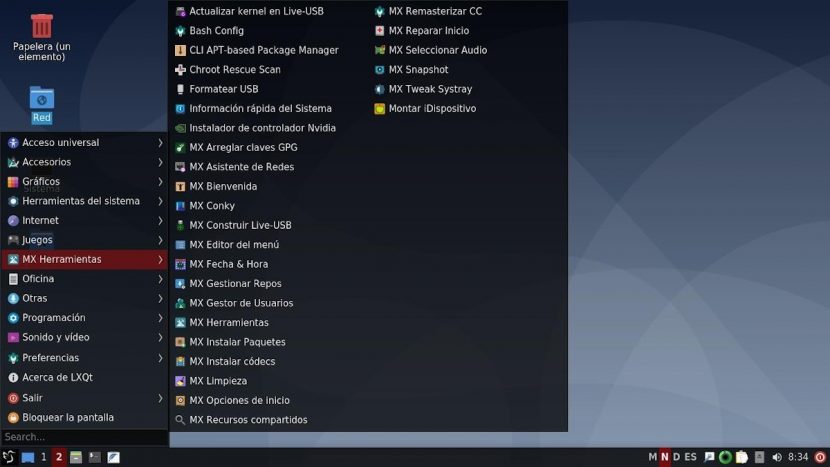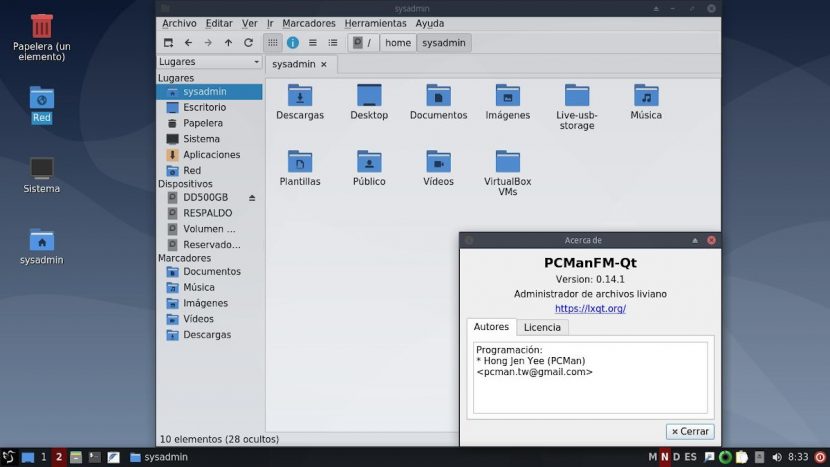
LXQT: What is it and how is it installed on DEBIAN 10 and MX-Linux 19?
LXQT is another light and fast Desktop Environment, brother of LXDE. And like the latter, there is usually no information about the web about other more popular and used ones. For example, our last post specific about LXQT, it was more than 5 years ago, on the version number 0.9.0.
Also, as with LXDE, there are usually few GNU / Linux distributions that include it like Default Desktop Environment. Therefore, in this publication we will focus especially on What is it?, and How do you install?. Emphasizing, of course, the current DEBIAN GNU / Linux meta-distribution, in its most recent version, number 10, code name Buster. Which is also currently the basis for the Distro MX-Linux 19 (Ugly Duckling).

Citing official information, the following can be expressed:
"LXQt is a lightweight Qt desktop environment. It won't get in your way. It won't crash or slow down your system. It is focused on being a classic desk with a modern look. LXQt has already been included in most Linux and BSD distributions, so you can try it on your normal system or in a VM. More information about the installation can be found on the LXQt Wiki on GitHub. Historically, LXQt is the product of the merger between LXDE-Qt, an initial flavor of LXDE's Qt, and Razor-Qt, a project that aims to develop a Qt-based Desktop Environment with objectives similar to the current LXQt. LXQt was supposed to become the successor to LXDE one day, but as of 09/2016 both desktop environments will continue to coexist for now. " "About" section of the LXDE official website

All about LXQT
Description
Among the most important that can be highlighted from this Desktop Environment we can mention the following points:
- LXDE was released partially in the year 2013 by the Taiwanese computer scientist Hong Jen Yee When finished PCManFM-Qt, the first desktop module QT. Over time, the full desk of LXQT, with the aim of making available a new, modern and lightweight Desktop Environment for low energy and resource consuming distributions, without completely abandoning the development of LXDE.
- LXQT it is made mainly in QT5 and other components in KDE Framework 5. And currently it goes by version 0.14.1 (stable). Its first and complete version was 0.7.0, released on May 7, 2014, as the first product of the merger of the project Razor-Qt y LXDE.
- LXQT is available through the official repositories in many GNU / Linux Distros, such as: DEBIAN, Ubuntu and Fedora. And some bring it by default when they are focused on low-resource consumption teams.
- El application ecosystem native to LXQT It is made up of several programs, the following being the most emblematic or well-known: PCManFM-Qt (File manager), Leafpad-Qt (Text editor), LXImage-Qt (Image Viewer), among many others.
Note: LXQT is Desktop Environment current carried out by Hong Jen Yee and its community of Developers, but have not abandoned the development of LXDEas they are trying to port it to GTK + 3 for compatibility with the Gnome3 Environment. Thus, how they carry LXQT with QT5 and KDE Frameworks 5 to achieve compatibility with the KDE Plasma environment.
Advantages and disadvantages
Advantages
- Provides a lightweight, integrated desktop environment, useful on computers with limited CPU and RAM memory resources or low performance. In addition, it is easy to use for many, thanks to a eye-catching interface but with traditional features.
- It is also maintained by a international developer community, many of whom work with LXDE.
- Its components retain the modular philosophy of its LXDE base, that is, they can be used independently of their own LXQT Desktop Environment.
Disadvantages
- It does not have its own window manager, but it is usually used mostly with open box. Although its integration with XFWM y Muffin.
- It has a Classic user interface despite its potential based on QT5 and KDE Frameworks 5.
- It is in full development and has not reached your first mature version (1.0) but your community is constantly growing, as your base has a lot of potential to offer.
For learn more you can visit its official website and that of its creator Distro:
Where you can access practical official sections, such as a Blog, Wiki and Forum, among many others. The following links are also available to supplement the information on LXQT:

Installation
In case one currently has a GNU / Linux DEBIAN 10 distribution (Buster) or others based on it, such as MX-Linux 19 (Ugly Duckling), the most recommended installation options are:
Using the Tasksel command via Graphical User Interface (GUI)
- Run a Console or Terminal from the Desktop Environment
- Run the command orders next:
apt update
apt install tasksel
tasksel install lxqt-desktop --new-install- Continue until the end on Tasksel Guided Procedure (Task Selector).
Using the Tasksel command via the Command Line Interface (CLI)
- Run a Console or Terminal using the Ctrl + F1 keys and start a superuser root session.
- Run the command orders next:
apt update
apt install tasksel
tasksel- Select the LXQT Desktop Environment and any other utility or set of additional packages.
- Continue until the end on guided procedure de Tasks (Task Selector).
Installing the minimum necessary packages directly via CLI
- Run a Console or Terminal from the Desktop Environment or using the Ctrl + F1 keys e start a superuser session root.
- Run the command orders next:
apt update
apt install lxqt- Continue until the end on procedure guided by Apt Package Installer.
Note: You can also install a Desktop Environment based on LXQT easier by replacing the package lxqt by lxqt-core.
Extra or complementary actions
- Execute actions of optimization and maintenance of the Operating System running the command orders next:
apt update; apt full-upgrade; apt install -f; dpkg --configure -a; apt-get autoremove; apt --fix-broken install; update-apt-xapian-indexlocalepurge; update-grub; update-grub2; aptitude clean; aptitude autoclean; apt-get autoremove; apt autoremove; apt purge; apt remove; apt --fix-broken install- Reboot and log in by selecting the Desktop Environment LXQT, in case of having more than one Desktop Environment installed and not having selected the Login Manager
lxqt-session.
For further information, visit the official pages of DEBIAN y MX-Linux, or the DEBIAN Administrator's Manual online in its stable version.
And remember, this is the last and sixth post of a series about GNU / Linux Desktop Environments. The previous ones were about GNOME, KDE Plasma, XFCE, Cinnamon, MATE y LXDE. There are many others Desktop Environments more than likely we'll explore in other future posts.

Conclusion
We hope this "useful little post" about him «Entorno de Escritorio» known by the name of «LXQT», brother of «LXDE», but with the difference that, it is written in Technology «QT», instead of «GTK+2», it has a classic desk with a modern look and is very little used / known within the world of «Distribuciones GNU/Linux», is of great interest and utility, for the entire «Comunidad de Software Libre y Código Abierto» and of great contribution to the diffusion of the wonderful, gigantic and growing ecosystem of applications of «GNU/Linux».
And for more information, always do not hesitate to visit any Online library as OpenLibra y jedit to read books (PDFs) on this topic or others knowledge areas. For now, if you liked this «publicación», don't stop sharing it with others, in your Favorite websites, channels, groups, or communities of social networks, preferably free and open as Mastodon, or secure and private like Telegram.
Or simply visit our home page at DesdeLinux or join the official Channel Telegram from DesdeLinux to read and vote for this or other interesting publications on «Software Libre», «Código Abierto», «GNU/Linux» and other topics related to «Informática y la Computación», and the «Actualidad tecnológica».
The last time I tried LXQt on Debian 10 it had some Xfce applications and its Xfwm composer and window manager. It did not seem to me to be well integrated. Apper was not loading the icons and the update notifier was missing.
On the other hand, the same distro with Plasma consumes the same or less. LXQt has lost consciousness.
Greetings, Autopilot. Until now that I have been with LXQT for more than 15 days, I have not seen any problem or slowness. And it is very beautiful and functional. Try again to see what you currently think.
What version is installed on debian?
0.14.1 or 0.12
Cheers! Argemiro. Use 0.14.1. Thanks for your comment.
Using the Tasks command via Graphical User Interface (GUI)
Run a Console or Terminal from the Desktop Environment
Run the command orders next:
apt update
apt install tasksel
install lxqt-desktop –new-tasks
Continue until the end on Tasksel Guided Procedure (Task Selector).
Using the Tasks command via the Command Line Interface (CLI)
Run a Console or Terminal using the Ctrl + F1 keys and start a super user root session.
Run the command orders next:
apt update
apt install tasksel
tasksel
Select the LXQT Desktop Environment and any other utility or set of additional packages.
Continue until the end on guided procedure of Tasksel (Task Selector).
It's reversed around isn't it?